Gaming is taking over the entertainment industry, as experts predict the numbers will hit 3.32 billion gamers worldwide by 2024. Interestingly, 56% of these gamers prefer playing console games.
It’s no surprise that gaming TVs are gaining prominence this year as most users veer away from watching movies to picking up more games. But not all gaming TVs are equal.
This article will delve into the leading gaming TVs on the market and will explore the top features businesses should look for before investing.
Table of Contents
Gaming TV vs. monitor: What are the differences?
Five trends to focus on
Features to look for in a gaming TV
Final words
Gaming TV vs. monitor: What are the differences?
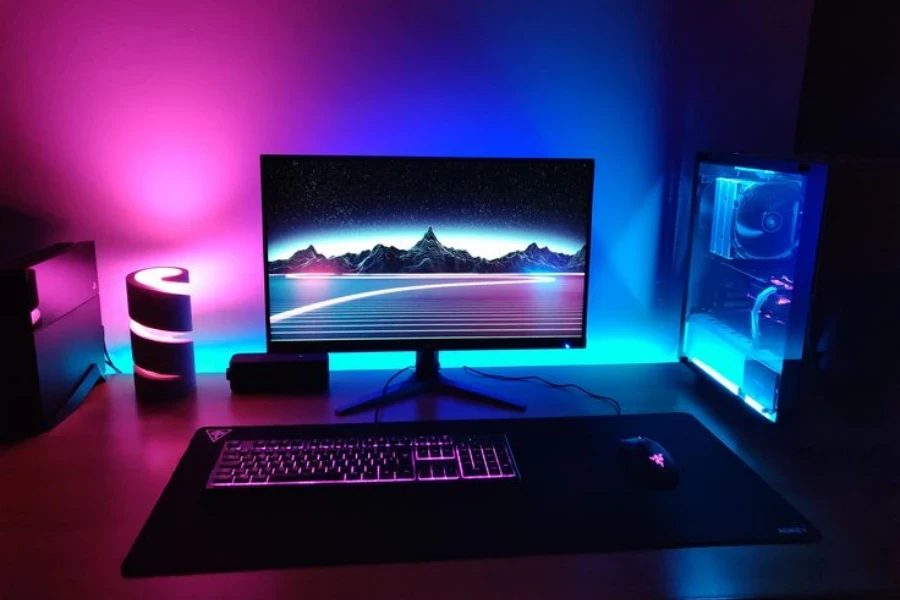
Gaming TVs and monitors may seem similar, but they have distinct features. Consumers often choose between a gaming monitor or a gaming TV, with monitors being the traditional choice for PC gaming and TVs gaining popularity for couch gaming and impressive resolutions.
However, there are more key differences businesses should consider to know why each one is unique:
Size
Display size is a significant factor when choosing between a gaming TV and a gaming monitor. Gaming monitors typically range from 21 to 32 inches, with 27 inches being common. Gaming TVs offer more extensive options, going up to 77 inches.
Check out the table below showcasing the different sizes for gaming TVs and monitors:
| Gaming monitors | Gaming TVs | |
| Small sizes | 20 inches or less | 32 to 42 inches |
| Standard sizes (perfectly balanced) | 21 to 26 inches | 43 to 55 inches |
| Large sizes | 27 to 55 inches | 56 to 83 inches |
Resolution
Resolution plays a pivotal role in consumers’ decisions between gaming TVs and monitors. Gaming monitors often offer 1080p resolution, suitable for most PC games.
On the other hand, gaming TVs prioritize higher resolutions like 4K, aligning with the capabilities of modern gaming consoles. Opting for 4K is recommended for those seeking sharper game visuals, especially with the latest gaming consoles like the PS5 and Xbox.
Response time, refresh rate, and input lag
The last factor differentiating gaming monitors and TVs is the display vs. console performance time, which refers to the response time, refresh rate, and input lag.
Here’s a table highlighting the general differences for each one:
Note: Some recent gaming TVs may have solved the slower response times and input lag issues.
| Display type | Response time (milliseconds) | Input lag (milliseconds) | Refresh rate/frame rates (hertz) |
| Gaming monitor | 1ms to 5ms | 1ms to 4ms | 60hz, 75hz, 100hz, 120hz, 144hz, and 240hz. |
| Gaming TV | 5ms and higher | 5ms to 16ms or higher | 60hz, 120hz, or 240hz |
Key takeaway: Gaming monitors are generally better for each category and offer more refresh rates than their TV counterparts. However, gaming TVs are still more than capable of handling various games smoothly.
Five trends to focus on
OLED
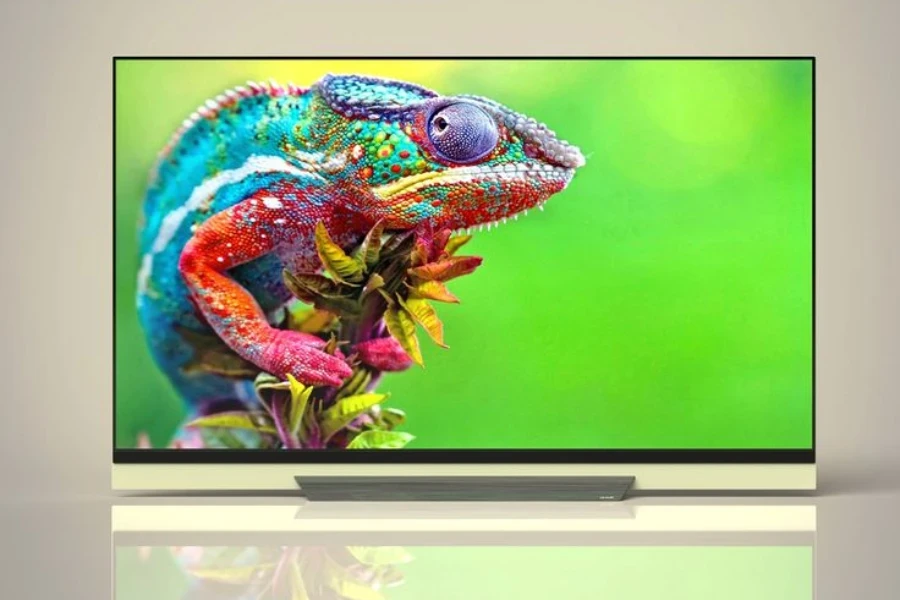
OLED TVs, introduced as far back as 1987, only found significant success in recent years after overcoming some technical challenges. Remarkably, the first commercially available OLED TV entered the market in 2013.
Since each pixel emits light and can be controlled individually, OLED swiftly supplanted traditional displays, solidifying its position as one of the industry’s top two display technologies. This assertion finds validation in the numbers: Google Ads data indicates an average monthly search volume of 450,000 for the keyword “OLED.”
But that’s not all. Another keyword, “OLED TVs,” hit an all-time high with 1.5 million searches in 2022 but has since declined by 11% to an average of 673,000 average monthly queries in 2023.
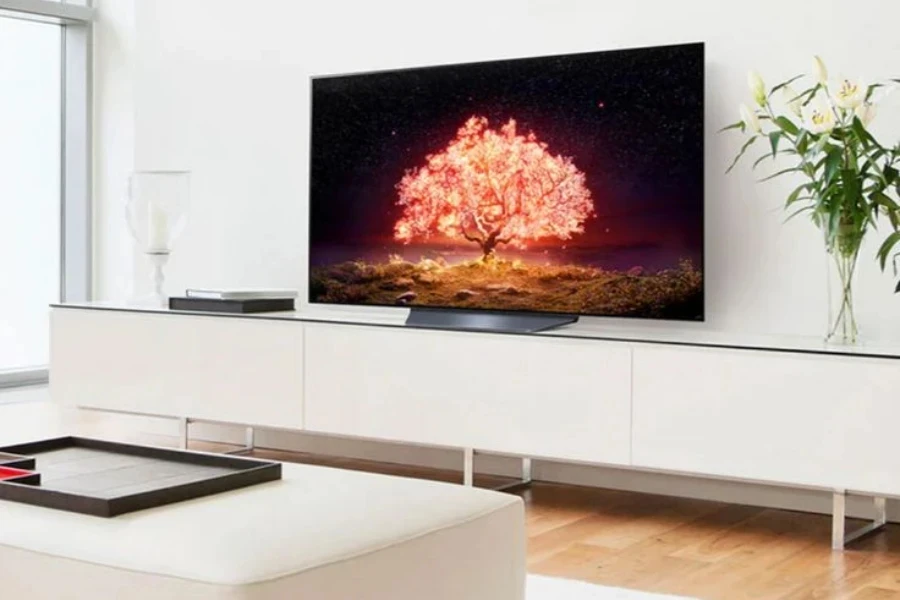
Pros
- OLED TVs offer unparalleled picture quality with perfect black levels and limitless contrast ratios, creating vivid colors and precise details.
- OLED TVs boast exceptional viewing angles, ensuring that consumers enjoy superb picture quality regardless of their seating position.
- These TVs also boast speedy response times, making them a perfect choice for gaming and watching high-speed action movies.
- Typically, OLED TVs are much thinner and lighter than other TV types. As a result, they also cater to the needs of space-conscious consumers.
Cons
- Burn-in is a common issue with OLED TVs, causing permanent image retention due to static images. Thankfully, Manufacturers have added features like pixel shifting and logo luminance adjustments to reduce this risk.
- OLED TVs are not as bright as other TVs, especially in HDR mode, due to limitations in their organic pixel technology. However, they still provide excellent picture quality, even in well-lit rooms.
- OLED TVs are costly due to their intricate manufacturing process, but prices are decreasing. Recent advancements in manufacturing efficiency and yield rates are expected to lower production costs, with a projected 20% price reduction for a 55-inch OLED panel this year and further cost savings expected through 2024.
QLED
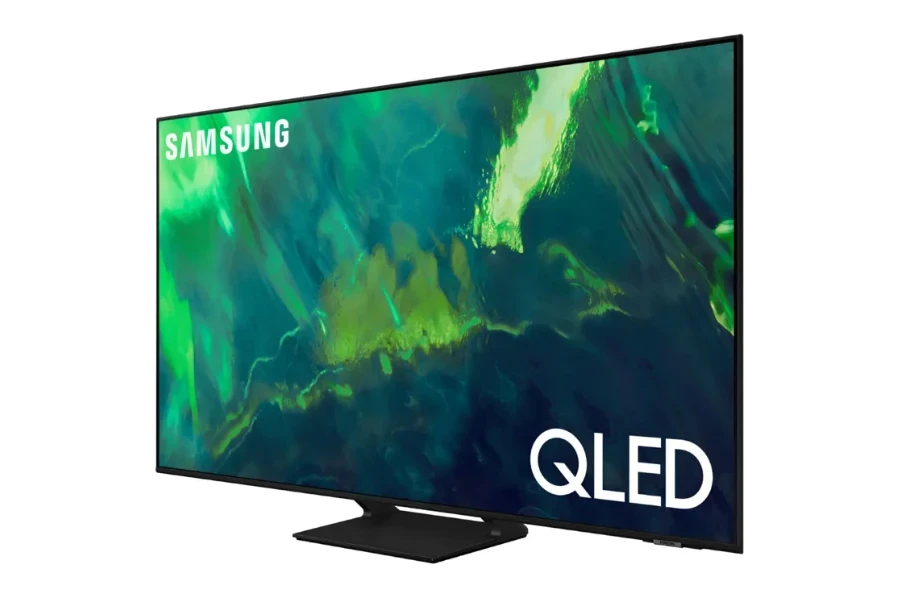
QLED (Quantum Light-Emitting Diode) gaming TVs have emerged as a compelling alternative to OLED TVs, garnering significant attention in recent years. These TVs function similarly to conventional LED TVs but harness the power of nanoparticles called quantum dots to enhance and enrich the displayed colors.
Sony initially introduced QLED backlights in 2013. However, Samsung took it up shortly by selling its line of QLED TVs. They also created licensing partnerships with other manufacturers, allowing QLED to penetrate the market further.
According to Google Ads data, QLED TVs have demonstrated their popularity and profitability through the performance of two high-performing keywords. The first, “qled tv,” receives an average of up to 135,000 monthly searches, while the second, “qled,” commands an impressive 165,000 queries.

Pros
- QLED TVs utilize quantum dots to create brighter, more vibrant colors than regular LED models. These quantum dots absorb various light wavelengths and emit specific ones, leading to more precise and saturated colors.
- QLED gaming TVs, like OLEDs, provide wide viewing angles, ensuring excellent picture quality even from off-center positions—thanks to their omnidirectional light emission.
- QLED TVs also have an impressive contrast ratio, producing deeper blacks and brighter whites—resulting in more realistic images. However, they’re not as good as OLED TVs.
- QLED TVs don’t suffer burn-in issues since they use backlight technology instead of individual organic pixels like OLED TVs.
Cons
- QLED TVs use backlighting to achieve near-perfect black levels, but they lack OLED’s precise control. So, the backlight is always on, even when displaying darker images.
- Blooming, where bright objects affect darker areas on the screen, can be problematic for QLED TVs, especially in darker scenes, as they are more susceptible to this issue.
8K display
While 4K remains the gaming TV standard, 8K resolution is gaining attention among visual quality-focused gamers. Recent models incorporate upscaling to mimic an 8K experience—but the main appeal of 8K gaming TVs is their future-proofing, as they offer the latest resolution, ensuring owners won’t need a display upgrade for years.
8K certainly lives up to its reputation. As per Google Ads, “8K TV” garners an impressive average of 165,000 monthly searches. This data underscores the substantial interest and potential customer engagement that 8K TVs command.
Moreover, “8K display” emerges as another high-performing keyword, boasting an average of over 27,100 monthly searches. Although it peaked at 40,500 monthly searches in 2022, it experienced a slight 4% decline in 2023, settling at 27,100 monthly queries. While not matching its previous high, it still sustains considerable interest.
Pros
- 8K TVs typically offer better color and contrast than 4K TVs, producing more shades and accomplishing deeper blacks.
- One attractive benefit of 8K TVs is their upscaling feature, as they can enhance lower-resolution content, improving the picture quality of older games.
- 8K TVs boast a resolution of 7680 x 4320 pixels, which is four times greater than 4K TVs—enabling them to display significantly more detail for sharper and lifelike images.
Cons
- 8K TVs are still relatively expensive, so they may not be affordable for everyone.
- Limited 8K content is available, so most of what consumers watch is upscaled from lower resolutions. However, as with past TV advancements, content creators are expected to adapt to 8K resolution in the coming years.
- On smaller screens below 55 inches, consumers may notice a slight difference between 4K and 8K resolutions, making the upgrade less noticeable.
Neo QLED TVs

Tech experts commonly compare OLED and QLED gaming TVs, with a few differences deciding the winner. However, Neo QLED TVs have emerged as an upgraded version of the existing QLED technology, primarily distinguished by their mini-LED backlighting, contrasting its predecessor’s LED backlighting.
Mini-LEDs are smaller than regular LEDs, which lets manufacturers pack more in different dimming zones. The results? Neo QLED can finely and precisely control the light, improving contrast ratios across the screen.
These TVs have two popular keywords: “Neo QLED” and “Neo QLED TVs.” The first keyword generates substantial search interest, with over 60,500 monthly searches. While the second one performs less strongly, it still attracts an average of 4,400 searches.
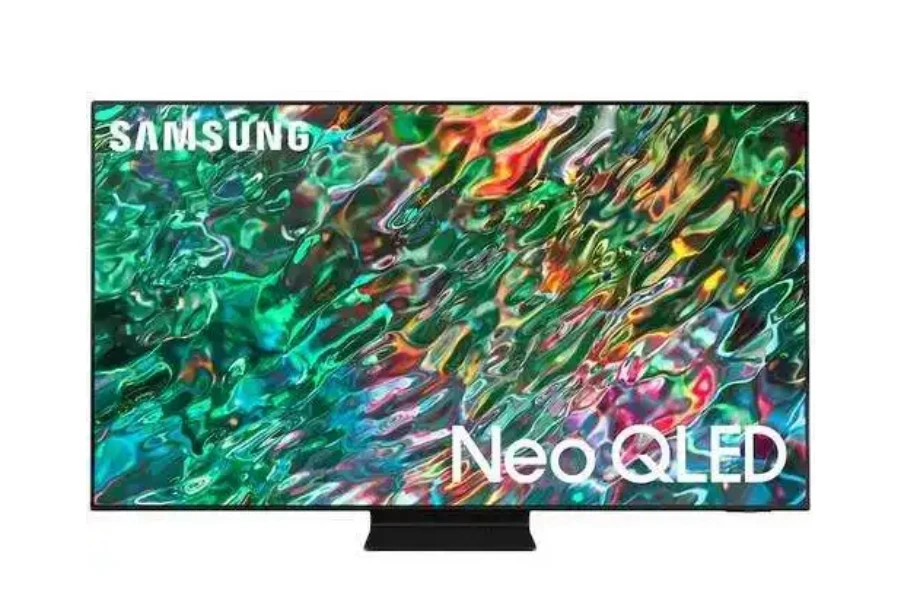
Pros
- Neo QLED TVs employ mini-LED backlighting, producing much brighter images than traditional ones. They’re particularly beneficial for gaming in HDR or well-lit environments.
- Neo QLED TVs use quantum dot technology to achieve more precise and vibrant colors than other TV types, evident in their wide color range.
- Neo QLED TVs feature an anti-reflection coating to reduce glare, allowing an uninterrupted gaming experience without distracting reflections.
Cons
- Although not as common as regular QLEDs, Neo QLED TVs may still suffer from blooming problems.
- Even with the anti-reflection coating on Neo QLED TVs, consumers may still notice some reflections in well-lit rooms.
Full-array gaming TVs

Full-array LED technology gained popularity in the 2010s as an advanced method for controlling image brightness and black levels. This technology uses an LED array behind the screen, granting more precise control over brightness and black levels.
They also offer improved contrast, deeper blacks, and precise local dimming control to enhance the overall picture quality. More importantly, full-array LED TVs are now widely regarded as one of the top television options available.
According to Google Ads data, “full-array LED TVs” receive an average of 6,600 monthly searches, suggesting a smaller yet focused group of consumers interested in the technology.
Pros
- Full-array LED TVs excel in color accuracy due to even LED distribution behind the screen, setting them apart from other TV types.
- Full-array LED TVs are attractive due to their minimal motion blur, making fast-moving visuals appear smoother and clearer.
Cons
- Consumers can’t control or calibrate a full-array TV’s LED zone individually.
- The entire backlight panel will fail if one LED zone doesn’t work.
Features to look for in a gaming TV
HDR
HDR (High Dynamic Range) is a sought-after feature for gaming TVs due to its enhanced contrast, reflected in its high popularity of 450,000 monthly searches on Google Ads.
While some TVs offer Auto HDR for all games, selecting a TV with high brightness levels is essential, aiming for at least 600 nits for a good HDR experience and 800 to 1000 nits for the most realistic picture quality.
High refresh rates
The refresh rate of a gaming TV determines how quickly it can update images and display frames per second. Gaming TVs usually offer refresh rates of 60Hz, 120Hz, or 240Hz, with 120Hz being the most common choice.
“120Hz TV” is the most popular refresh rate choice, with 40,500 monthly searches on Google Ads. “240Hz TVs” come in second with over 1,900 searches, while “60Hz TVs” are the least favored, with only 880 searches.
Note: Some variants may offer variable refresh rates, which adjust the TV’s frame rate to match the gaming console.
Multiple HDMI ports
HDMI 2.1 is the most advanced HDMI technology, and opting for gaming TVs with the updated port is the best choice for consumer gamers who prefer the highest frame rates.
Businesses must also consider opting for TVs with multiple HDMI ports and an HDMI eARC to allow their customers to connect their consoles and other devices, like soundbars. Check for other inputs like Ethernet, USB, coaxial, and s-video on the gaming TV.
Low input lag
Low input lag is a crucial factor for gamers, and businesses should seek gaming TVs with minimal input lag to attract consumers. Google Ads data indicates a high consumer interest in this feature, with over 22,000 monthly searches for “input lag.”
Most gaming TVs have input lag ranging from 5 ms to 16 ms or higher, so retailers should aim for models with less than 20 ms to ensure a seamless gaming experience.
Built-in gaming engines
Certain gaming TVs have a built-in gaming engine, a software that automatically optimizes the experience. TVs with this technology deliver the smoothest gameplay by detecting the game the consumer is playing and adjusting settings accordingly.
More importantly, consumers won’t have to navigate menus or guess which settings are best-– the gaming engine takes care of everything, making their gaming experience hassle-free.
Final words
Bringing home a new gaming console is an exciting experience, especially with the latest features in the gaming world. The next step to fully enjoy a new console is connecting it to a gaming TV, making it an essential part of a consumer’s gaming setup.
Gaming TVs have evolved from regular LED TVs to top-tier technologies like OLED, full-array, and QLED, to more advanced displays like Neo QLED and 8K. These are the gaming TV trends set to dominate the market.




